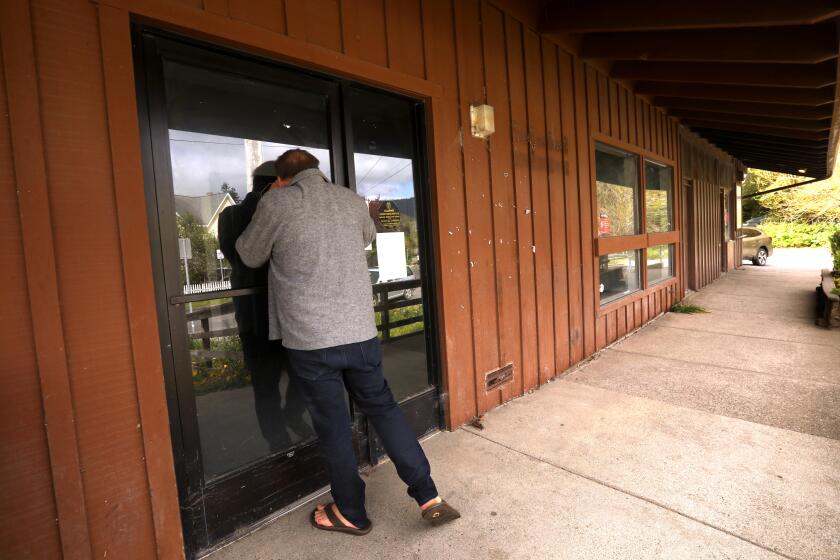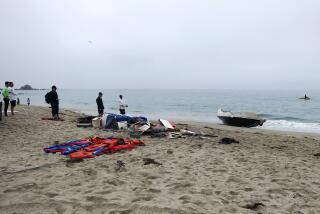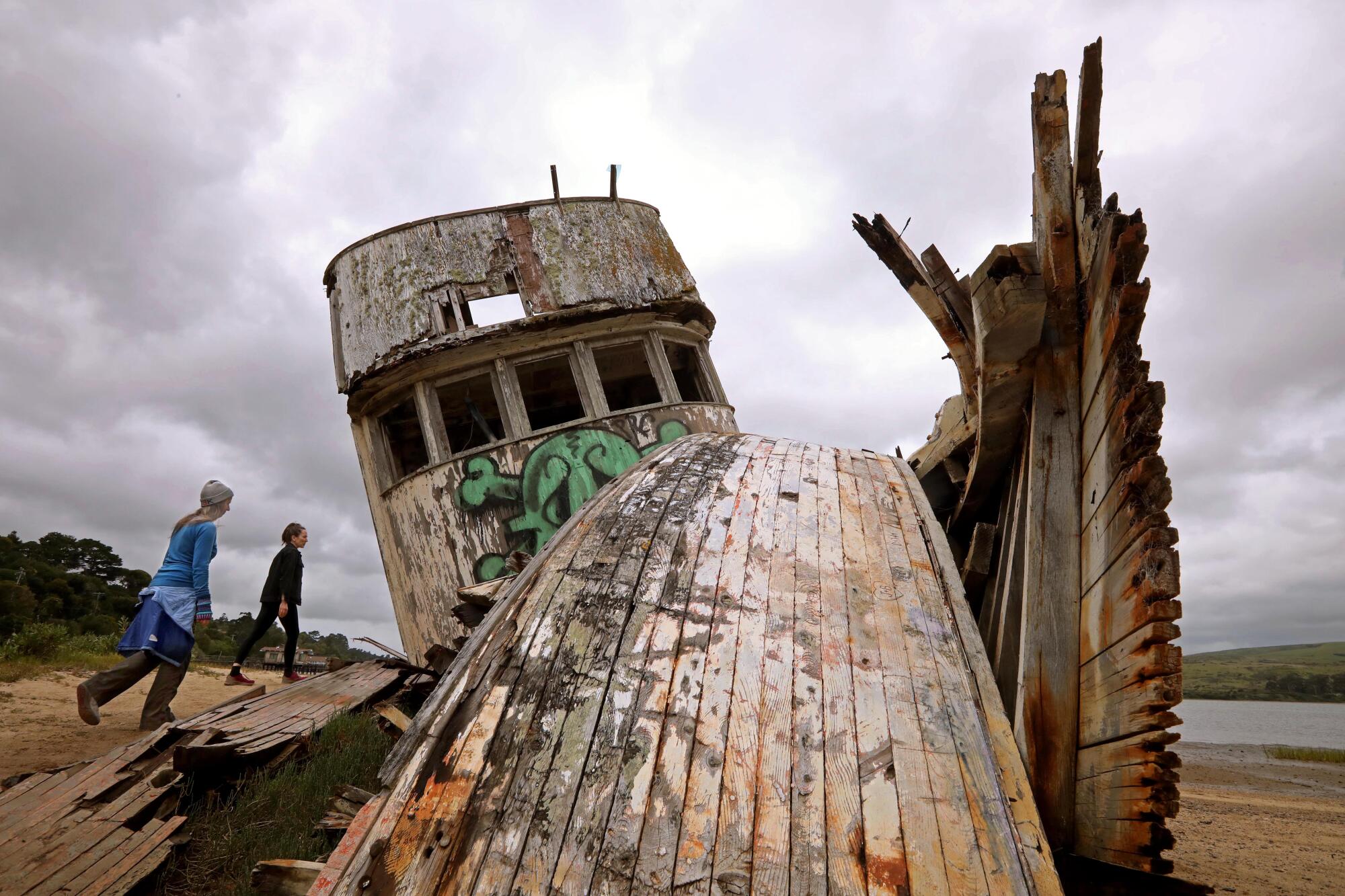
INVERNESS, Calif. — It once was beautiful, the S.S. Point Reyes, even as it slowly rotted on the banks of Tomales Bay.
But now, its hull is shattered; its innards, rusty and charred. Moss clings to its damp wooden planks, and graffiti mars its chipped paint. It lists precariously toward its starboard side.
The abandoned fishing boat — stuck on a mudflat in the tiny town of Inverness since the late 1990s, residents say — found its fame long after its working days were done.
Its resting place was pinpointed on Google Maps as “Point Reyes Shipwrecks,” proving irresistible for travelers on nearby Highway 1. It was geotagged on Instagram, where it became the muse of multitudes of cellphone photographers.
The S.S. Point Reyes, as it is known, has been the backdrop for engagement photos and music videos, for quiet lunch breaks and illicit nighttime beers. People climbed it, trashed it and, at one point, accidentally set it on fire.
It has been beloved and abused. And its days appear to be numbered.
The wind and rain from this winter’s record-setting storms sounded the death knell for the boat, which rests at the edge of Tomales Bay, a narrow inlet above the San Andreas fault that separates the Point Reyes Peninsula from mainland Marin County.
The vessel “endearingly termed ‘the shipwreck’ ” is on National Park Service land and will eventually be removed, Anela Kopshever, a spokeswoman for Point Reyes National Seashore, said in an email.
“The boat has deteriorated over time, but recent winter storms, king tides, and vandalization has contributed to its current state,” Kopshever said.
But first, another wreck: This spring, she said, the Park Service has been more focused on removing the Westerly, a boat that crashed in late March near Chimney Rock on the Point Reyes Headlands, killing a Dungeness crab fisherman.
Kopshever said the Westerly, which park officials hope to pull off the rocks by the end of this summer, “has critical environmental and wildlife impact,” with nets, crab pots, the engine block and other materials threatening seabirds.
The Point Reyes, she said, is not currently affecting the environment or wildlife — mostly, it endangers reckless humans — and there is not yet a set date for its removal.
Still, whether they love it or hate it, townsfolk in Inverness say it’s time for the boat to go.
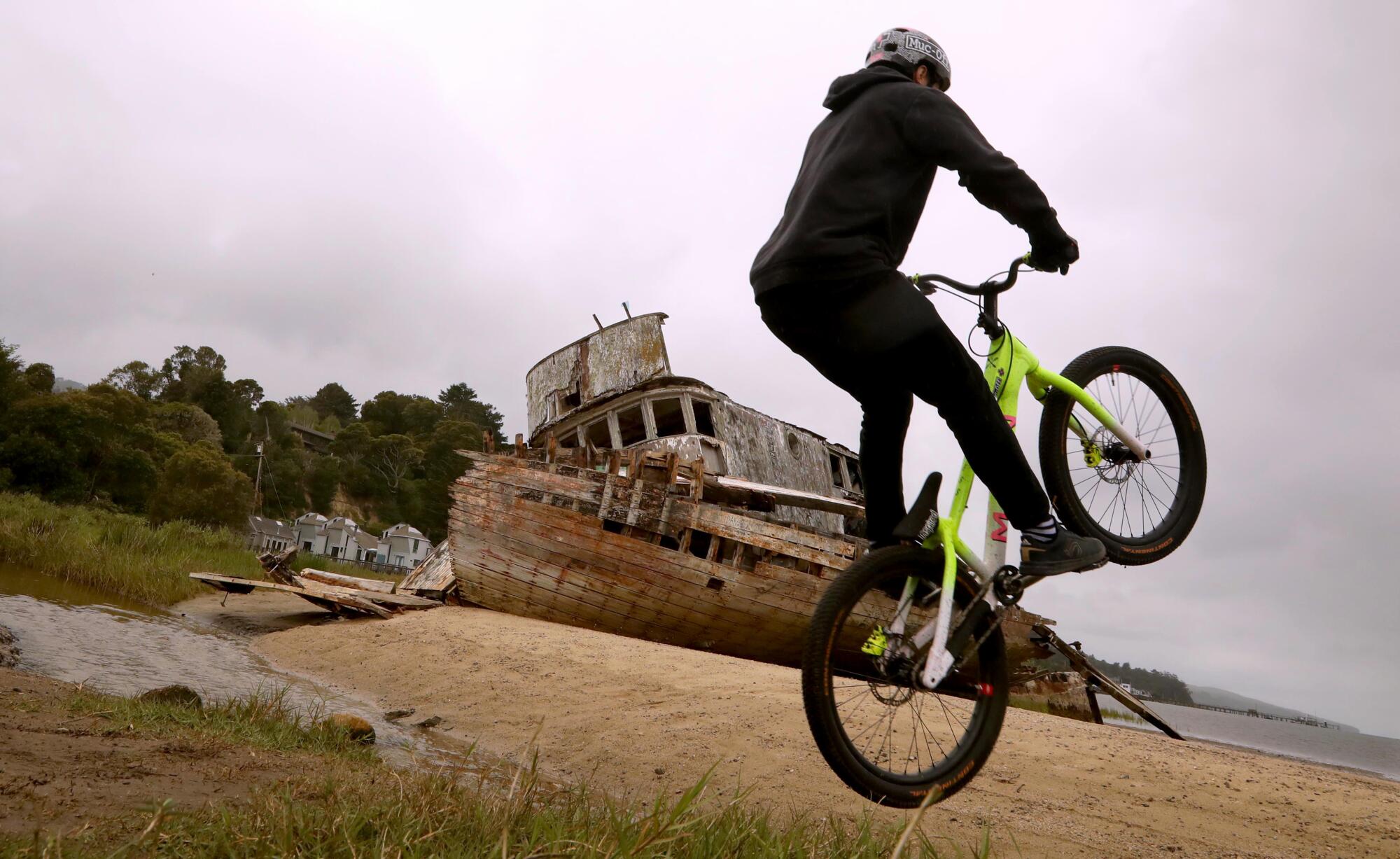
“I’m so over it. It’s just a sad story,” said Rebecca Dixon, whose business, Dixon Marine Services, a wetlands restoration firm, sits in front of the dilapidated vessel.
On a fence behind her business, beside the path most walk to reach the S.S. Point Reyes, a metal sign reads: HAVE SOME RESPECT.
The Point Reyes Peninsula, surrounded by cold, churning waters, treacherous crags and impenetrable fog, has spelled doom for generations of seafarers.
Starting with the San Agustin — a three-masted Spanish galleon lost in Drake’s Bay in 1595 — more than 50 vessels are known to have wrecked around the Point. They include “lumber ships and oil tankers, fishing scows and dairy schooners,” according to the National Park Service.
On a windswept bluff near the Point Reyes Lighthouse, a trail sign, quoting an 1887 newspaper article, reads: “Punta de los Reyes — Point of the Kings — Spanish navigators named it … and they did well to fear it. God help the hapless mariner who drifts upon it.”
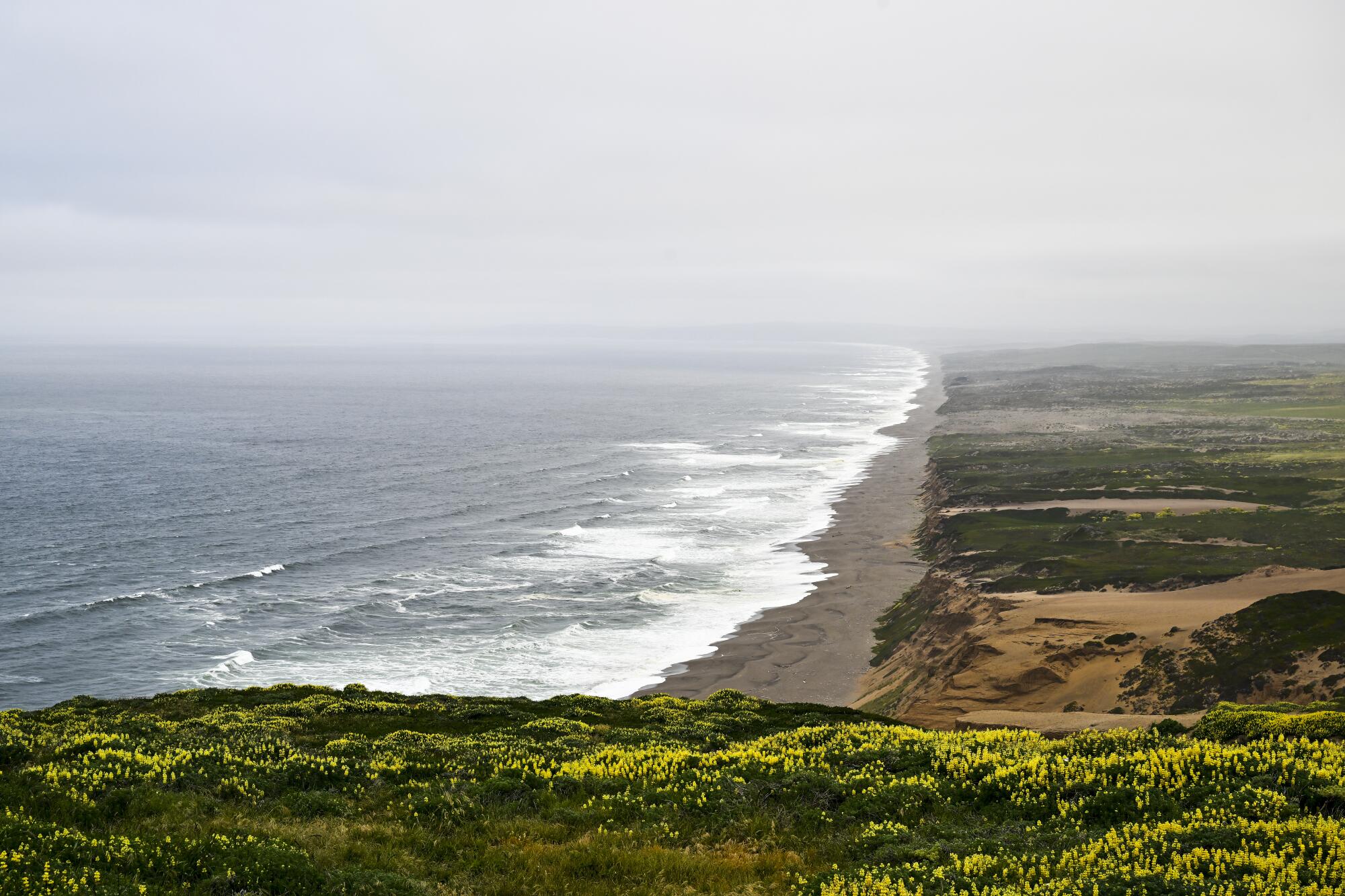
Though this is a place of briny lore, the fate of the Point Reyes has been greatly exaggerated.
For starters: It is not a shipwreck. Viral social media posts claim the boat is a 380-foot steamship — which is longer than a football field and about 10 times its actual size — and that it crashed 100 years ago.
“That’s just silly,” said Freedom Rocca, whose late grandfather, an Indigenous Coast Miwok fisherman, was one of the boat’s last owners.
She said her grandfather, Merrel Rocca Sr., sold the boat to a man who intended to restore it but eventually abandoned it on the shore. Rocca, 41, grew up in Marshall, an oyster-farming town where fishing boats were a common sight. She has long been baffled by the fame of the Point Reyes.
“Sometimes, I’ll go to art galleries, and it’s like, ‘There it is! The boat!’’’ People paint it. They photograph it. ... I don’t understand what the big deal is. It’s a boat that’s tipped on the side of the beach.”
Still, she wishes she knew more about it, and about her grandfather, who died in 1989 when she was 6.
“The older I get, the cooler I think it is,” Rocca said. “I’m like, you know what, that’s my grandfather’s boat.”
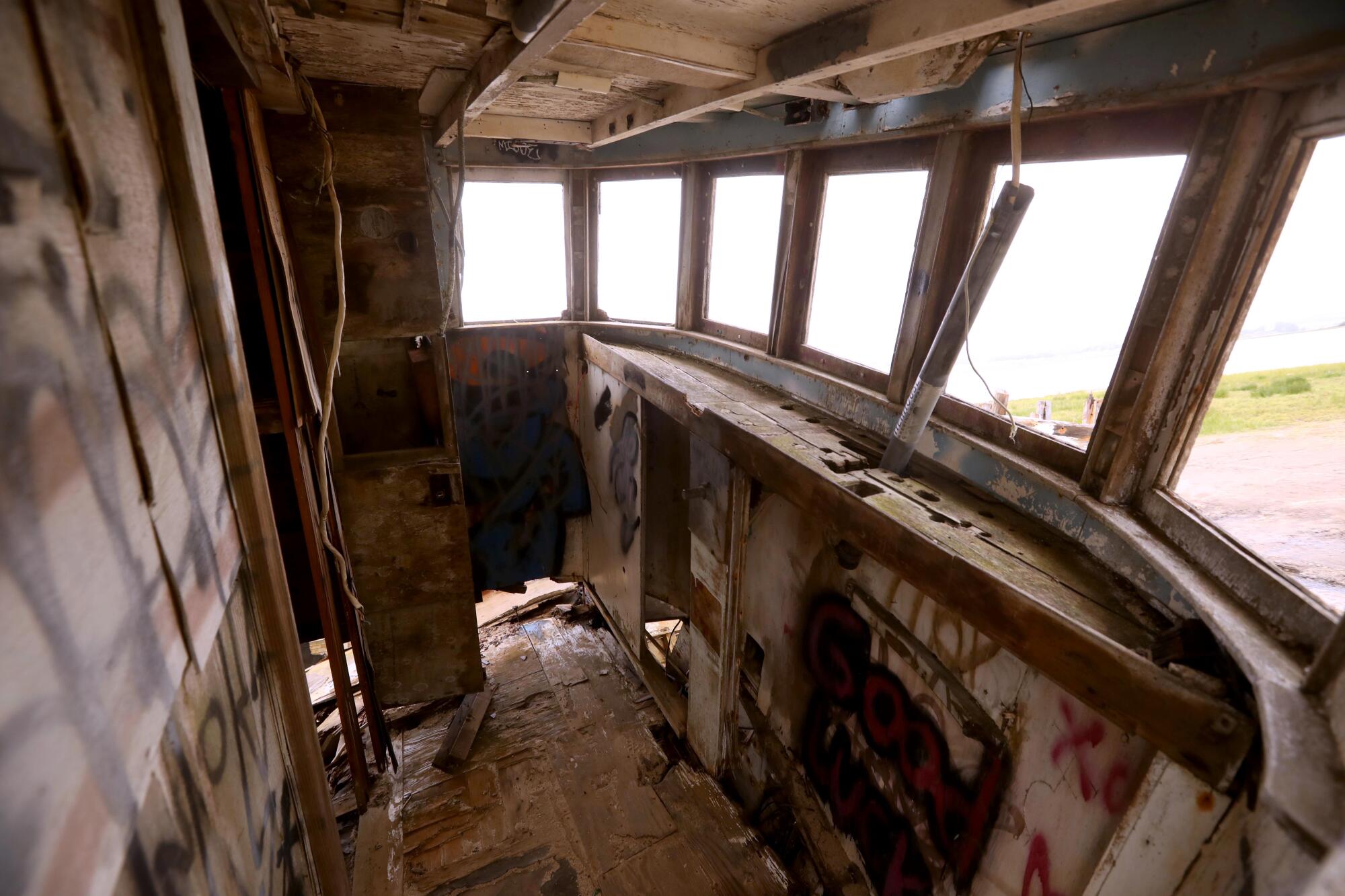
Ownership of the land where the Point Reyes sits has also changed over the years, which has complicated the vessel’s removal. Multiple federal and state agencies have jurisdiction in the bay and surrounding areas, and they often tussle over who is responsible for paying to clean up crashed boats and other marine junk.
In 2022, the California State Lands Commission unsuccessfully sought a $14.9-million grant from the National Oceanographic and Atmospheric Administration to clean up marine debris along the coast of Sonoma and Marin counties.
The project would have funded the cleanup of hundreds of discarded tires in Marconi Cove, which lie in eelgrass beds that would otherwise serve as fish nurseries, as well as a collapsing pier in Bodega Bay. And it would have paid to remove 14 vessels — including the Point Reyes and the American Challenger, a 90-foot fishing boat that broke free in 2021 while being towed from Puget Sound, Wash., to Mexico to be scrapped. It got stuck on a rocky reef in the Greater Farallones National Marine Sanctuary about an hour north of Inverness.
The NOAA “did not explain why our grant application was not selected,” Sheri Pemberton, a spokeswoman for the lands commission, said in an email.
The American Challenger was uninsured, leaving public agencies, including the Environmental Protection Agency and the U.S. Coast Guard, responsible for the multimillion-dollar salvage operation. The boat remains.
Rich Moorer, a spokesman for Point Reyes National Seashore, said officials are monitoring the deterioration of the Point Reyes. A potential removal, he said, could be funded by the park.
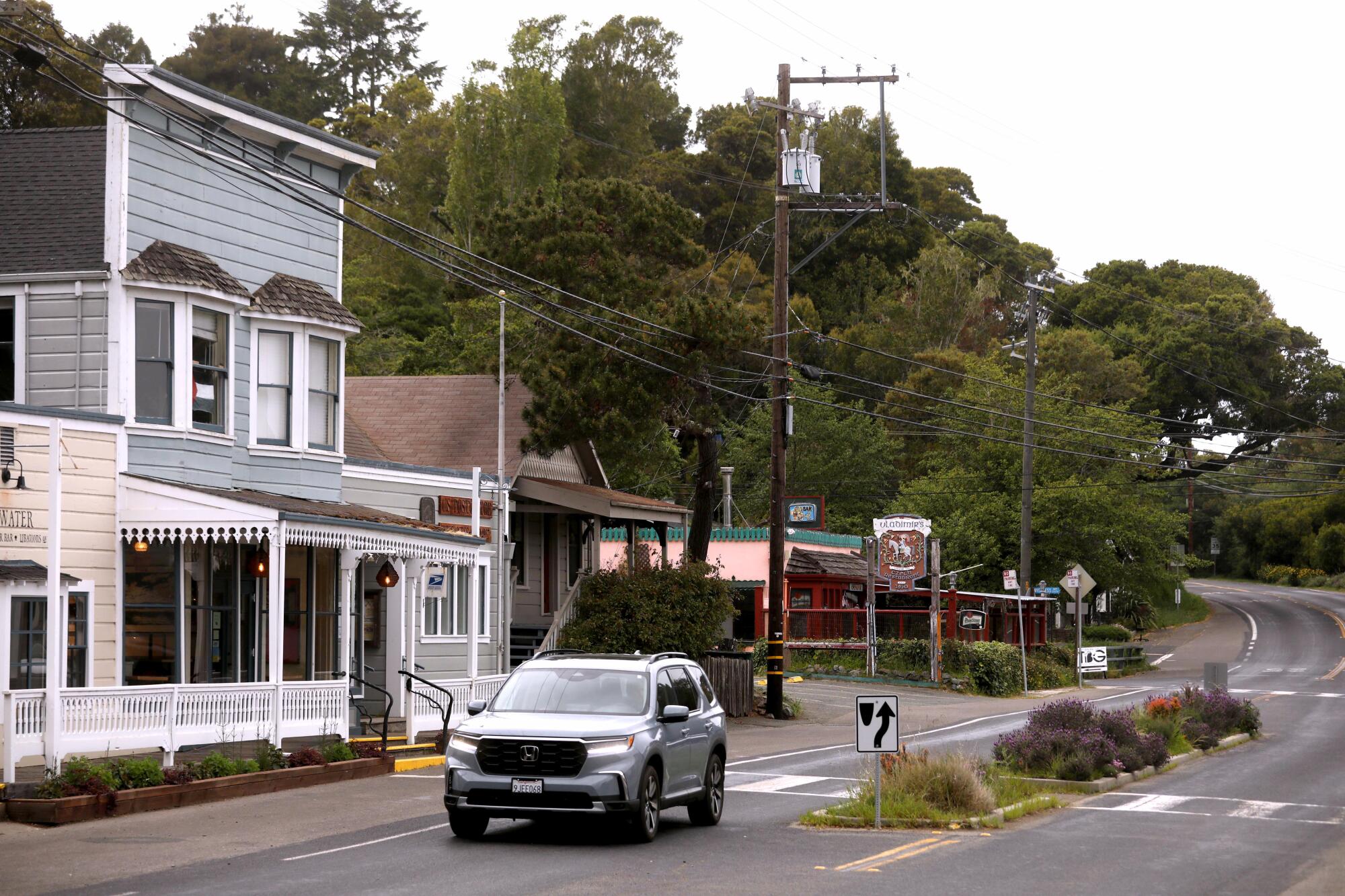
After years of slow decay, the Point Reyes really started falling apart after it caught fire in 2016, shortly after a photo was posted to Instagram that showed arcing sparks from someone apparently burning steel wool and spinning it, a technique called light painting.
The fire badly damaged the boat’s stern. Eventually, the starboard side of its hull — which bore the vessel’s much-photographed name — collapsed, and a grinning green skull and crossbones were painted on the front of its cabin.
Still, the tourists come.
The 1,500 citizens of Bolinas, ZIP Code 94924, lost their post office more than 15 months ago. They are fighting to get it back with their most cherished tool: creativity.
On a recent, misty Tuesday, Raj Singh, who owns the Inverness general store in front of the boat, said it is getting more dangerous.
“The last year or so, it’s really gotten bad,” he said. “It’s deteriorated to a point where they have to get rid of it because ... people do stupid things.”
The boat was stuck in the mud when Singh, who emigrated from England, bought the store two decades ago. He used to have an outdoor oyster bar next to the store that he called The Sunken Boat, and he sells hoodies with its image.
“Some people don’t like the eyesore. And there are people like us who just think it’s cool,” he said. When it is eventually removed, “we definitely will miss it — but I know a lot of people won’t.”
Outside, a steady stream of people parked in Singh’s parking lot, tromped through the damp grass and crossed a rickety wooden plank fashioned as a bridge over the ankle-deep water flowing in front of the boat after recent rains.
Duncan Shaw, a professional bike rider from Inverness, Scotland, showed up with his neon-green Marin Bikes two-wheeler, shooting selfies with the Point Reyes in the background.
“I just did a little video on Instagram. I said I was in California for a week and haven’t seen a cloud in the sky, and as soon as I showed up here, it started raining,” like in his oft-wet hometown, Shaw said. “The power of Inverness is far-reaching.”
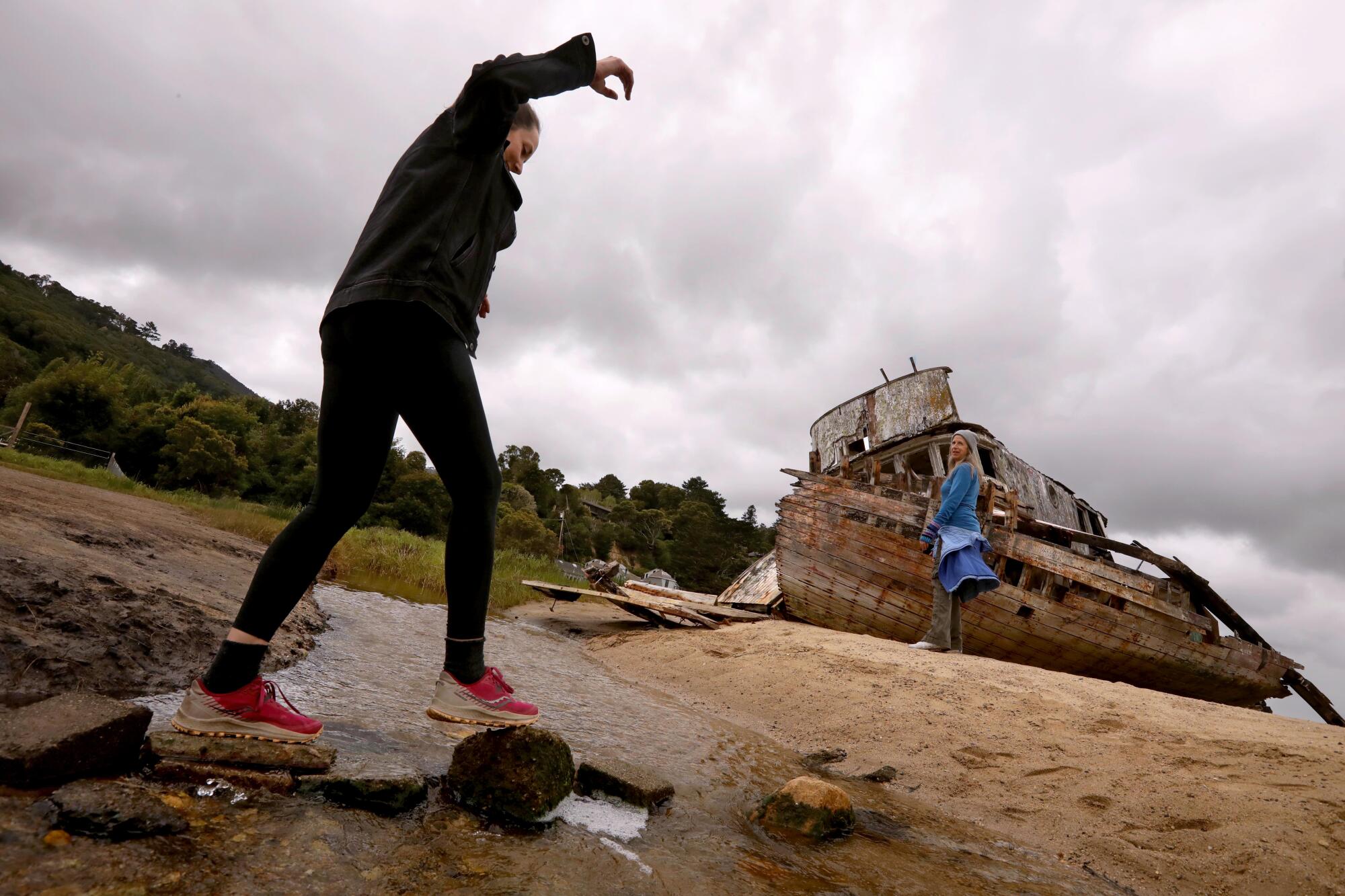
Diana Oppenheim, a yoga teacher who lived for several years in San Francisco but moved home to Detroit during the COVID-19 pandemic, choked up when she saw the Point Reyes. It was her first visit in years.
She used to lead volunteer groups in Point Reyes National Seashore, doing dune restoration followed by yoga on the beach. Often, they would stop at the wreck to rest, eat lunch and take photos.
“If the ship had a life to it, it would have no idea that it was still just sitting and bringing so much joy and awe and mystery to people,” she said.
Oppenheim was traveling with her friend, Charity Kahn, a meditation teacher and composer of children’s music from Oakland who just released The Vegan Album, brimming with lyrics such as: Oh if you care about animals // And you love ‘em and adore ‘em // And you wanna be kind // Don’t eat ‘em anymore.
Kahn said the dilapidated boat, to her, represents the march of time, “even though we try to avoid impermanence.”
“It’s this human creation on the edge of earth,” she said. “And yet, at the same time, it’s receding back into earth and becoming earth again.”
More to Read
Sign up for Essential California
The most important California stories and recommendations in your inbox every morning.
You may occasionally receive promotional content from the Los Angeles Times.
